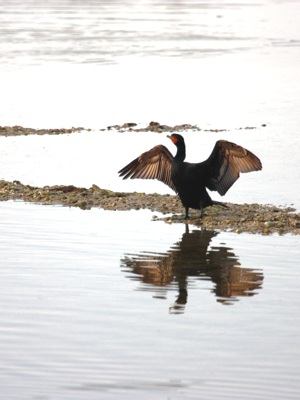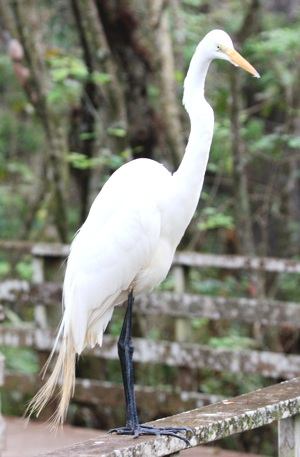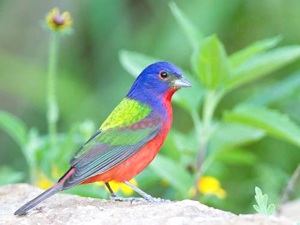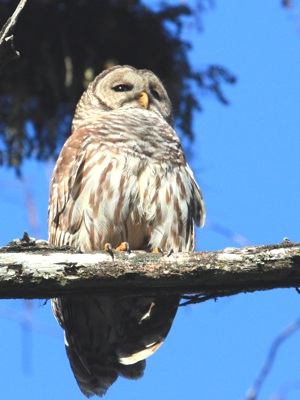Travel Tips
Five Birding Hotspots & Tips for Fledgling Birders
If you’re looking for a different spring break activity, consider birding. Some still call it geeky, but birding has become a hot pursuit in the U.S. One in five Americans now spends time watching the graceful creatures, and the number who travel to seek, spot, and identify birds has risen 8 percent since 2001, according to a government survey. Lynn Langway reports on top birding spots around the country as well as 7 Tips for Fledgling Birders.
Birding doesn’t have to be difficult; sometimes, the birds find you. That’s how it seems, at least, at two of my favorite wildlife preserves in southwest Florida, where the birds tend to be big, plentiful and close, making them easy to see. Beginners will also like the accessible trails, multiple guided tours and hundreds of helpful volunteers at Audubon’s Corkscrew Swamp Sanctuary, north of Naples, and the J.N.”Ding” Darling National Wildlife Refuge on Sanibel Island. Another advantage of these two destinations: should a newbie ever tire of birding, she can always retreat to the glorious Gulf beaches nearby.
At Corkscrew, a 2.25 mile boardwalk twists through varied habitats– wet prairies, pine uplands and an ancient grove of Bald Cypress, studded with orchids and swamp lilies–that shelter more than 200 species of migratory and resident birds. Come early, and you might encounter new birds at every turn, especially if you sign up in advance for a guided hike. When my husband and I took a 7 a.m. walk one winter morning, we were startled by a booming cry that sounded like “Who-Cooks-for-You?” We looked up to see a Barred Owl, its big body vibrating with each hoot. A few turns later, I found myself eye-to-eye with a Great Egret, who was lounging on the boardwalk railing as if he’d been waiting for me. Our two engaging guides and 10 fellow birders—the walks are limited to 12—helped us identify several tiny warblers that can be tricky to spot. With their assistance, we ended up logging 26 different species during our three-hour stay—-including two new –to-us Painted Buntings, brilliantly bedecked in chartreuse, red, and blue plumage.
At Ding Darling, a Red-Shouldered Hawk was doing his best Eagle imitation atop the flagpole when we arrived soon after sunrise. Named after the conservationist who lobbied for its creation, this outstanding refuge is run by the U.S. Fish & Wildlife Service, and offers a full calendar of classes, tours, and lectures. Travel the 4-mile wildlife drive by car, tram, and bike or on foot, and you might view 220-plus species on these 6400 acres of mangrove forest and marshes. But be sure to arrive close to low tide when the peak crowd of wading birds gathers to drill for food ; at high tide, the birds disperse to their hidden roosts. When we gazed out from the observation tower, at least a dozen Roseate Spoonbills were vacuuming the mud with their comical spatulate beaks, their feathers glowing in shades of pink from shell to flamingo. Arrayed around them were scores of Great and Little Blue Herons, Ibis, Egrets, and Anhingas, while flocks of White Pelicans and hundreds of shorebirds wheeled and turned overhead.
Birding Hotspots
Many other birding hotspots around the U.S. are great places to get hooked on this healthy outdoor hobby for the whole family. Some standouts:
California
Point Reyes National Seashore: Located on a peninsula 30 miles north of San Francisco, this wildly beautiful national park provides matchless birding and 111-acres of windswept scenery. Because it juts 10 miles into the Pacific, Pt. Reyes draws seabirds normally seen far from shore, such as Storm Petrel s, Albatrosses and the occasional Tufted Puffin, along with a wealth of ducks, hawks, songbirds, and two threatened species, the Snowy Plover and Spotted Owl. In addition to 490 species of birds, you might also watch migrating Gray Whales and Elephant Seals between December and April, and Tule Elk in the summertime.
Ohio
Magee Marsh Wildlife Area. Thousands of migrating songbirds―orioles, thrushes, and 37 varieties of warbler—stop at this 2000-acre refuge near Toledo to rest and refuel every spring before crossing Lake Erie and flying on to their homes farther north. Stroll the 6-mile boardwalk from mid-April to mid-May, and you’re likely to see scores of bright, small, exhausted warblers raining from the sky to perch near the railings. You’re also like to see plenty of the resident American Eagles, as well as migrating ducks and hawks.
Texas
Santa Ana National Wildlife Refuge. Run by the U.S. Fish and Wildlife Service south of McAllen, TX, this 2,080 acre tropical haven on the banks of the lower Rio Grande showcases nearly half of North America’s butterfly species as well as nearly 400 resident and migrating birds including the vibrant, blue-cockaded Green Jay and the comical Chachalaca, a pheasant –sized bird that’s not hard to identify, since it often squawks its name and then crashes through the brush. Scout them from 12 miles of hiking trails, two towers, and a 7-mile wildlife drive you can walk or ride in a tram.
Seven Tips for Fledgling Birders
1. Do your homework
Study the informative park websites before you go. Look over the lists, descriptions and photos of birds you’re likely to see at your destination, along with schedules of festivals, tours and lectures.
2. Pick the right time to go
There’s a reason the early bird gets the worm; he/she also usually gets the best birds, because they’re most active right after sunrise. That can vary, though; some birds are best seen right before sunset when they’re returning to the roost, while waders are most visible at low tide. Consider seasons, too.
3. Bring binoculars
You can’t really appreciate hawks overhead or songbirds in the bush without them. Many places offer loaners; check first.
4. Don’t overspend
Birding can be a costly habit, so until you know how much you like it, settle for modest equipment such as serviceable binoculars for less than $200. Plus, you want a field guide. Two good, affordable resources:
- the iBird Explorer Plus for iPhone , iPad and Androids, which uses photos as well as drawings and allows you to look up birds by size, shape, and behavior and, listen to their calls (calling them, however, is controversial; many experts say this can confuse and exhaust the birds.)
- Peterson First Guide to Birds of North America, which shows useful silhouettes of birds in flight and perched by the road as well as drawings of common North American birds, available in print or app for iPhone, and iPad.
5. Take advantage of visitors’ centers
Many offer films, bird lists, guides, advice, maps, photo clinics and more, free with admission.
6. Take notes
Keeping a list of the birds you’ve seen makes the experience more memorable and more fun—more like collecting. But don’t let yourself become a “lister,” too obsessed with the hunt for new species to enjoy the beauties of familiar birds.
7. Be patient, ask questions, and learn from others
Most birders love to share (and brag!).
What activities are you trying out this spring break? Is birding on your list? Share your bird spotting experiences.
For more eco-travel and birding ideas, check out Lynn’s previous articles:
- Birding in Belize on an Independent Shore Excursion
- Everglades National Park: An Eco-Travel Vacation in Florida
- Peru’s Wilder Side: Go Beyond Machu Picchu to the Manu Biosphere
By Lynn Langway for PeterGreenberg.com. Lynn Langway is an award-winning editor, writer and journalism teacher. Visit her on the Web at www.lynnlangway.com.

















